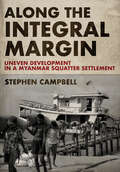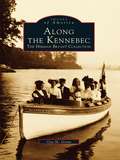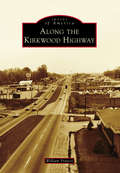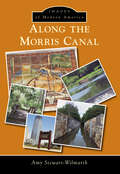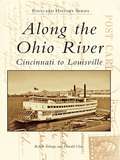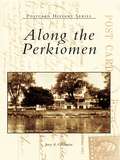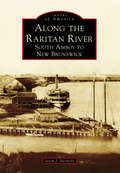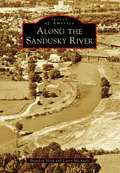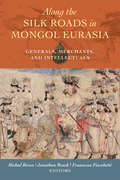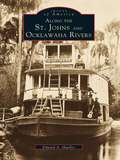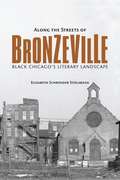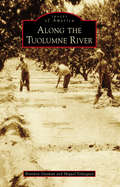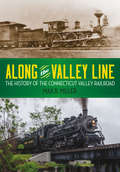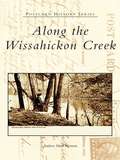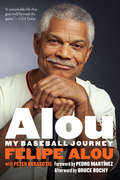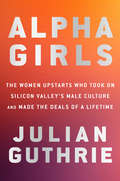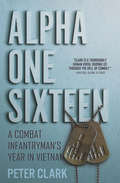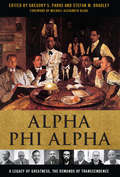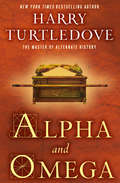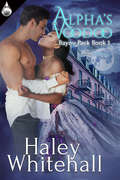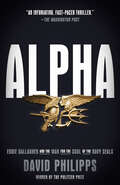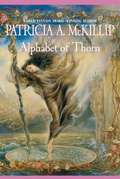- Table View
- List View
Along the Integral Margin: Uneven Development in a Myanmar Squatter Settlement
by Stephen CampbellIn recent years anthropologists have focused on informal, unfree, and other nonnormative labor arrangements and labeled them as "noncapitalist." In Along the Integral Margin, Stephen Campbell pushes back against this idea and shows that these labor arrangements are, in fact, important aspects of capitalist development and that the erroneous "noncapitalist" label contributes to obscuring current capitalist relations.Through powerful, intimate ethnographic narratives of the lives and struggles of residents of a squatter settlement in Myanmar, Campbell challenges narrow conceptions of capitalism and asserts that nonnormative labor is not marginal but rather centrally important to Myanmar's economic development. Campbell's narrative approach brings individuals who are often marginalized in accounts of contemporary Myanmar to the forefront and raises questions about the diversity of work in capitalism.
Along the Kennebec: The Herman Bryant Collection
by Gay M. GrantThis wonderful new book takes us back in time to visit the rural communities that thrived along the banks of the Kennebec River around the turn of the century--from Augusta and Gardiner down to Merrymeeting Bay on the coast. Local author Gay M. Grant has brought together more than two hundred beautiful photographs taken by gifted local photographer Herman Bryant between 1890 and 1936. This volume makes these photographs available to the public for the first time. The images bring to life the people, places, and events that defined the history of the area during this exciting era. We see the Kennebec River at its industrial peak, when industries such as lumber, paper, ice, and shipbuilding lined its banks. We encounter buildings such as Maine's old capitol building (before its refurbishment) and the Blaine House as it used to look. We witness terrible tragedies such as the train wreck of 1905, and share in local celebrations too. We experience the Age of Steam and the Age of Sail in their heyday. Most important of all, we meet the people who lived and loved, worked and played in these communities throughout this fascinating period. Through the pages of this book, our past reaches out to us.
Along the Kirkwood Highway
by William FrancisThe Kirkwood Highway is an almost six-mile portion of State Route 2 in New Castle County, Delaware. Built as a bypass of Marshallton after the opening of Delaware Park at Stanton in 1937, it was meant to provide Wilmington-area horse-racing fans a straighter and faster route to the track. It is named after a distinguished officer of the American Revolution, Robert Kirkwood Jr., who was born at his family's farm along Polly Drummond Hill Road in Newark in 1756. Since it opened to automobile traffic, the highway has undergone numerous renovations and the scenery along its route has changed dramatically. Today, it is the fifth-busiest roadway in the state and is lined by shopping centers, national retailers, fast-food and chain restaurants, gas stations, subdivisions, and historic sites. Through vintage photographs, Along the Kirkwood Highway takes a nostalgic look back at the travel corridor, its cross streets, and familiar sites along its path.
Along the Morris Canal
by Amy Stewart-WilmarthDug by hardworking men in the late 1820s, the Morris Canal is considered to be an engineering marvel. Comprised of 34 locks and 23 inclined planes, it created a waterway from the Delaware River in Phillipsburg, across northern New Jersey, and down into the Hudson River in Jersey City. It was drained in 1924, with its prisms mostly filled in. The 1960s brought a steadfast movement for the preservation of the largely buried Morris Canal, including the historic Silas Riggs Saltbox House being rescued from demolition and later the opening of the restored Waterloo Village. These challenging years set in motion the formation of organizations and societies dedicated to protecting, restoring, and preserving the Morris Canal. Through the persistent efforts and dedication of historians, canal enthusiasts, and neighboring communities, the Morris Canal and its buried history are gradually being unearthed. This book captures the Morris Canal's original pathway and its restoration and preservation accomplishments.
Along the Ohio River: Cincinnati to Louisville
by Robert Schrage Donald ClareThe Ohio River is not only a river of scenery and beauty, but also one of opportunity. It is a river of journey and exploration; a river of dreams, both personal and private; a river of commerce and enterprise. It is also a river of floods and destruction. Along the Ohio River: Cincinnati to Louisville journeys down this dynamic river. The postcard images show many riverfront scenes, from the cities along the way to excursion steamboats, river scenery, and the river at work.
Along the Perkiomen
by Jerry A. ChiccarineThe Perkiomen Creek is a picturesque stream that drains a major portion of western Montgomery County. It begins just beyond the northern borders of the county and travels south. The creek empties into the Schuylkill River at the county's lower border. The old Perkiomen Railroad closely followed the same path. Along the Perkiomen showcases postcards of the Perkiomen Valley in Montgomery County as it existed during the first half of the twentieth century. Readers will visit the villages and towns along the creek and others nearby. This visual journey is intended to provide a glimpse of the Perkiomen region's rich history.
Along the Raritan River: South Amboy to New Brunswick
by Jason J. SlesinskiThe Raritan River is the largest river in New Jersey, flowing from the state's western mountains for approximately 16 miles toward the tidewaters of New Brunswick, from which point it widens over 14 miles before reaching the Raritan Bay. By the end of the 20th century, this estuary, known as the Lower Raritan River, was one of the most polluted in the nation. The very industrialization that brought economic prosperity to the communities along the Lower Raritan River was also the origin of the river's contamination. Today, however, the waterway is making a comeback. Along the Raritan River: South Amboy to New Brunswick includes historical maps and photographs to tell the story of this changing cultural landscape and its natural beauty and resources, historic floods, economic enterprise, devastating pollution, and continued renewal and recovery.
Along the Sandusky River (Images of America)
by Brandon Hord Larry MichaelsThe Sandusky River flows nearly 130 miles, roughly in the shape of a capital "C," through the northern Ohio towns of Bucyrus, Upper Sandusky, Tiffin, and Fremont, and into Lake Erie's Sandusky Bay. A portage near its source allowed Native American tribes to reach the Scioto River and travel by water from Lake Erie all the way to the Gulf of Mexico. The War of 1812 brought forts and battles, and the defeat of the British at Fort Stephenson was the first major American victory of the war. Over the years, the Sandusky has provided fish to eat, power for mills, and shipping routes for business and trade. It also, on occasion, has brought floods and devastation to its nearby inhabitants. Designated an Ohio Scenic River since the 1970s, the Sandusky is still the lifeblood flowing through the heart of its region.
Along the Santa Fe Trail: Marion Russell's Own Story (Into Reading, Trade Book #4)
by James Watling Ginger Wadsworth Marion RussellNIMAC-sourced textbook. An adaptation of the author's biography, Land of Enchantment, describes her eventful 1852 journey with her mother and brother from Kansas to California over the Santa Fe trail in a large wagon train.
Along the Silk Roads in Mongol Eurasia: Generals, Merchants, and Intellectuals
by Michal Biran Jonathan Brack Francesca FiaschettiDuring the thirteenth and fourteenth centuries, Chinggis Khan and his heirs established the largest contiguous empire in the history of the world, extending from Korea to Hungary and from Iraq, Tibet, and Burma to Siberia. Ruling over roughly two thirds of the Old World, the Mongol Empire enabled people, ideas, and objects to traverse immense geographical and cultural boundaries. Along the Silk Roads in Mongol Eurasia reveals the individual stories of three key groups of people—military commanders, merchants, and intellectuals—from across Eurasia. These annotated biographies bring to the fore a compelling picture of the Mongol Empire from a wide range of historical sources in multiple languages, providing important insights into a period unique for its rapid and far-reaching transformations. Read together or separately, they offer the perfect starting point for any discussion of the Mongol Empire’s impact on China, the Muslim world, and the West and illustrate the scale, diversity, and creativity of the cross-cultural exchange along the continental and maritime Silk Roads.Features and Benefits:Synthesizes historical information from Chinese, Arabic, Persian, and Latin sources that are otherwise inaccessible to English-speaking audiences.Presents in an accessible manner individual life stories that serve as a springboard for discussing themes such as military expansion, cross-cultural contacts, migration, conversion, gender, diplomacy, transregional commercial networks, and more.Each chapter includes a bibliography to assist students and instructors seeking to further explore the individuals and topics discussed.Informative maps, images, and tables throughout the volume supplement each biography.
Along the St. Johns and Ocklawaha Rivers
by Edward A. MuellerIn the early days of the nineteenth century, water was a significant means for transporting both goods and people throughout this burgeoning nation, and the state of Florida was no exception. Since Florida has ocean access on the east, west, and south, and numerous waterways that serve the interior, the state's development has been greatly influenced by the rivers that wind through its beautiful and varied landscape. The people and vessels that traveled these waters were an integral part of the region's economy and took part in the often romanticized steamboat era. Of all Florida's natural waterways, the St. Johns River was perhaps the best suited for steamboat use, and the Ocklawaha River was one of its main tributaries. These valuable river routes encouraged the growth and prosperity of such Florida towns as Jacksonville, St. Augustine, Fernandina, and Palatka, and tourist attractions such as Silver Springs.
Along the Streets of Bronzeville: Black Chicago's Literary Landscape
by Elizabeth Schroeder SchlabachAlong the Streets of Bronzeville examines the flowering of African American creativity, activism, and scholarship in the South Side Chicago district known as Bronzeville during the period between the Harlem Renaissance in the 1920s and the Black Arts Movement of the 1960s. Poverty stricken, segregated, and bursting at the seams with migrants, Bronzeville was the community that provided inspiration, training, and work for an entire generation of diversely talented African American authors and artists who came of age during the years between the two world wars. In this significant recovery project, Elizabeth Schlabach investigates the institutions and streetscapes of Black Chicago that fueled an entire literary and artistic movement. She argues that African American authors and artists--such as Gwendolyn Brooks, Richard Wright, Langston Hughes, painter Archibald Motley, and many others--viewed and presented black reality from a specific geographic vantage point: the view along the streets of Bronzeville. Schlabach explores how the particular rhythms and scenes of daily life in Bronzeville locations, such as the State Street "Stroll" district or the bustling intersection of 47th Street and South Parkway, figured into the creative works and experiences of the artists and writers of the Black Chicago Renaissance. Providing a virtual tour South Side African American urban life at street level, Along the Streets of Bronzeville charts the complex interplay and intersection of race, geography, and cultural criticism during the Black Chicago Renaissance's rise and fall.
Along the Toms River (Images of America)
by Ocean County Historical SocietyThis fascinating visual history features more than two hundred carefully selected photographs that together document the people, places, and events that have defined the city of Toms River and the surrounding area. Located on the banks of the river of the same name, Toms River was first settled in the early 1700s by loggers drawn to the dense forests on the river's banks. During the American Revolution, the village was a constant thorn in the side of the British, and it was attacked and burned to the ground in 1783. The arrival of the railroads in the late 1800s ushered in a new age of expansion which, spurred on by the construction of the Garden State Parkway in the decade after World War II, continues to this day.
Along the Tuolumne River
by Miguel Velazquez Brandon GuzmanThe Tuolumne River begins up in the Sierra Nevada and flows through Mariposa County, Tuolumne County, and, finally, Stanislaus County. From its origins to the endpoint flowing into the San Joaquin River, it provides life and an economic source for this entire region. Once a major shipping route, it now provides irrigation water to one of the most agriculturally industrious regions in the world. The history of the Tuolumne River is the story of Stanislaus County and the surrounding areas.
Along the Valley Line: The History of the Connecticut Valley Railroad (Garnet Bks.)
by Max R. MillerThe Connecticut Valley Railroad once carried both passengers and freight along the west bank of the Connecticut River between Hartford and Old Saybrook. Completed in 1871, today the railroad is known throughout New England for the nostalgic steam-powered excursion trains that run on a portion of the line between Essex and Chester. Until now the history of this popular tourist attraction has been the stuff of local lore and legend. This book, written by railroad historian and former vice president and director of Valley Railroad, Max R. Miller, provides the first comprehensive history of the Connecticut Valley Railroad through maps, ephemera, and archival photographs of the trains, bridges, and scenery surrounding the line. Offering tales of train wrecks, ghost sightings, booms and busts, Along the Valley Line will be treasured by railroad enthusiasts and historians alike.
Along the Wissahickon Creek (Postcard History Series)
by Andrew Mark HermanOriginally called Wisauksicken and Wisamickon by the Lenni Lenape tribe of southeastern Pennsylvania, the creek was renamed Wissahickon by European settlers in the late 1600s. The Wissahickon, beginning as a small stream fed by underground springs in central Montgomery County, winds its way down into a breathtaking valley in Philadelphia's Fairmount Park before entering the Schuylkill River. Rich in history and scenic beauty, the creek has played a major part in the development of the area. Early mills were established along its banks, and during the American Revolution, Washington's army set up encampments in the creek valley. Since becoming part of Fairmount Park in 1868, the Wissahickon has continued to be the focus of land preservation and is now part of the Wissahickon Green Ribbon Preserve.
Alou: My Baseball Journey
by Felipe Alou Peter Kerasotis Pedro MartínezGrowing up in a tiny shack in the Dominican Republic, Felipe Alou never dreamed he would be the first man to go from his country to play and manage in Major League Baseball—and also the first to play in the World Series. Today, the Dominican Republic produces more Major League players than any country outside the United States. In this extraordinary autobiography, Alou tells of his real dream: to become a doctor. An uncle was funding his university education when an improbable turn of events intervened at the 1955 Pan American Games. There as a track and field athlete, Alou was pressed into service on the baseball field to replace a player sent home for disciplinary reasons. A scout noticed Alou and offered him two hundred pesos to sign a pro contract. Knowing his father owed the grocer exactly two hundred pesos, Alou signed. Battling racism in the United States and political turmoil in his home country, Alou persevered, paving the way for younger brothers Matty and Jesús and scores of other Dominicans, including his son Moisés. A fourth Alou brother, Juan, might have joined the historic trio if not for the improbable direction his own life took. Alou played seventeen years in the Major Leagues, accumulating more than two thousand hits and two hundred home runs, and then managed another fourteen—four with the San Francisco Giants and ten with the Montreal Expos, where he became the winningest manager in franchise history. Alou became a special friend of Roberto Clemente, roomed with Willie McCovey, Orlando Cepeda, Juan Marichal, and Joe Torre, and suffered the tragic death of his firstborn son. Alou’s pioneering journey is embedded in the history of baseball, the Dominican Republic, and a remarkable family.
Alpha Beta: How 26 Letters Shaped The Western World
by John ManThe idea behind the alphabet - that language with all its wealth of meaning can be recorded with a few meaningless signs - is an extraordinary one. So extraordinary, in fact, that it has occurred only once in human history: in Egypt about 4000 years ago. Alpha Beta follows the emergence of the western alphabet as it evolved into its present form, contributing vital elements to our sense of identity along the way. The Israelites used it to define their God, the Greeks to capture their myths, the Romans to display their power. And today, it seems on the verge of yet another expansion through the internet.Tracking the alphabet as it leaps from culture to culture, John Man weaves discoveries, mysteries and controversies into a story of fundamental historical significance.
Alpha Girls: The Women Upstarts Who Took On Silicon Valley's Male Culture and Made the Deals of a Lifetime
by Julian GuthrieAn unforgettable story of four women who, through grit and ingenuity, became stars in the cutthroat, high-stakes, male dominated world of venture capital in Silicon Valley, and helped build some of the foremost companies of our time. In Alpha Girls, award-winning journalist Julian Guthrie takes readers behind the closed doors of venture capital, an industry that transforms economies and shapes how we live. We follow the lives and careers of four women who were largely written out of history - until now. Magdalena Yesil, who arrived in America from Turkey with $43 to her name, would go on to receive her electrical engineering degree from Stanford, found some of the first companies to commercialize internet access, and help Marc Benioff build Salesforce. Mary Jane Elmore went from the corn fields of Indiana to Stanford and on to the storied venture capital firm IVP - where she was one of the first women in the U.S. to make partner - only to be pulled back from the glass ceiling by expectations at home. Theresia Gouw, an overachieving first-generation Asian American from a working-class town, dominated the foosball tables at Brown (she would later reluctantly let Sergey Brin win to help Accel Partners court Google), before she helped land and build companies including Facebook, Trulia, Imperva, and ForeScout. Sonja Hoel, a Southerner who became the first woman investing partner at white-glove Menlo Ventures, invested in McAfee, Hotmail, Acme Packet, and F5 Networks. As her star was still rising at Menlo, a personal crisis would turn her into an activist overnight, inspiring her to found an all-women's investment group and a national nonprofit for girls.These women, juggling work and family, shaped the tech landscape we know today while overcoming unequal pay, actual punches, betrayals, and the sexist attitudes prevalent in Silicon Valley and in male-dominated industries everywhere. Despite the setbacks, they would rise again to rewrite the rules for an industry they love. In Alpha Girls, Guthrie reveals their untold stories.
Alpha One Sixteen: A Combat Infantryman's Year in Vietnam
by Peter ClarkIn this &“great and necessary addition to the canon of Vietnam War memoirs&” the author &“is a thoroughly human Virgil guiding us through the hell of combat&” (New York Journal of Books). Peter Clark&’s year in Vietnam began in July 1966, when he was shipped out with hundreds of other young recruits as a replacement in the 1st Infantry Division. Assigned to the Alpha Company, Clark gives a visceral and vivid account of life in the platoon as he progresses from green recruit to seasoned soldier over the course of a year. Alpha One Sixteen follows Clark as he discovers how to handle the daily confusion of distinguishing combatants from civilians. The Viet Cong were a largely unseen enemy who fought a guerrilla war, setting traps and landmines everywhere. As he continues his journey, Clark gradually learns the techniques for coping with the daily horrors he encounters, the technical skills needed to fight and survive, and how to deal with the awful reality of civilian casualties. Fighting aside, it rained almost every day, and insect bites constantly plagued the soldiers as they moved through dense jungle, muddy rice paddies, and sandy roads. From the food they ate to the inventive ways they managed to shower—and the off-duty time they spent in the bars of Tokyo—every aspect of the platoon&’s lives is explored in this revealing book. A Military Book Club main selection.
Alpha Phi Alpha: A Legacy of Greatness, the Demands of Transcendence
by Gregory S. Parks and Stefan M. BradleyA “thoughtful” historical and sociological look inside the fraternity that’s shaped men from W.E.B. DuBois to Martin Luther King, Jr. to Thurgood Marshall (Choice).On December 4, 1906, on Cornell University’s campus, seven black men founded one of the greatest and most enduring organizations in American history. Alpha Phi Alpha Fraternity Inc. has brought together and shaped such esteemed men as Martin Luther King Jr., Cornel West, Thurgood Marshall, Wes Moore, W.E.B. DuBois, Roland Martin, and Paul Robeson. “Born in the shadow of slavery and on the lap of disenfranchisement,” Alpha Phi Alpha—like other black Greek-letter organizations—was founded to instill a spirit of high academic achievement and intellectualism, foster meaningful and lifelong ties, and racially uplift those brothers who would be initiated into its ranks.In Alpha Phi Alpha, Gregory S. Parks, Stefan M. Bradley, and other contributing authors analyze the fraternity and its members’ fidelity to the founding precepts set forth in 1906. They discuss the identity established by the fraternity at its inception, the challenges of protecting the image and brand, and how the organization can identify and train future Alpha men to uphold the standards of an outstanding African American fraternity. Drawing on organizational identity theory and a diverse array of methodologies, the authors raise and answer questions that are relevant not only to Alpha Phi Alpha but to all black Greek-letter organizations.
Alpha and Omega
by Harry TurtledoveNew York Times bestselling author Harry Turtledove reveals a new side of his potent imagination in a gripping speculative novel about the End of Days—and a discovery in the Middle East that turns the world upside down.What would happen if the ancient prophecy of the End of Days came true? It is certainly the last thing Eric Katz, a secular archaeologist from Los Angeles, expects during what should be a routine dig in Jerusalem. But perhaps higher forces have something else in mind when a sign presaging the rising of the Third Temple is located in America, a dirty bomb is detonated in downtown Tel Aviv, and events conspire to place a team of archaeologists in the tunnels deep under the Temple Mount. It is there that Eric is witness to a discovery of such monumental proportions that nothing will ever be the same again. Harry Turtledove is the master at portraying ordinary people caught up in extraordinary events, and what is more extraordinary than the incontrovertible proof that there truly is a higher force controlling human destiny? But as to what that force desires . . . well, that is the question.
Alpha's Voodoo
by Haley WhitehallWith her reputation in tatters, debutante Violet Creed is forced to exchange her life of luxury for one of uncertainty. Mark Afton wants nothing more than to take his rightful place as the leader of the Bayou Pack, but he needs a mate. Is Violet Mark's destined mate, or is their attraction merely Voodoo magic? Haley Whitehall is pleased to present Alpha's Voodoo, Book 1 of her hot, new, paranormal romance series, Bayou Pack.Are curses real or merely imagined?Violet Creed is a colored New Orleans debutante. She was brought up with servants and a strict set of rules regarding propriety, and her papa never approved of her interest in Voodoo. One night she sneaks out of the house and attends one of Marie Laveau's gatherings--where she loses her virginity and her reputation. Turned out by her papa, Violet is destined for a life on the streets until Madam Dawn saves her.Cursed to live as a wolf shifter, Mark Afton is a wealthy lawyer and heir to the Bayou Pack. Unfortunately, he can't take over leadership from his uncle without a mate. Wanting to escape his mother's endless matchmaking attempts, he accepts Madam Dawn's invitation to sail on the maiden voyage of the Southern Rose and enjoy the pleasurable company of her ladies.One of Madam Dawn's recent hires catches his attention. He is drawn to Violet immediately. Could she be his mate or is their attraction merely Voodoo?Content Notes: Hot, Historical, Multi-Cultural, Paranormal, Spirits, Magic, Witches, Shifters, Wolves
Alpha: Eddie Gallagher and the War for the Soul of the Navy SEALs
by David PhilippsAn epic account of the Navy SEALs of Alpha platoon, the startling accusations against their chief, Eddie Gallagher, and the courtroom battle that exposed the dark underbelly of America&’s special forces—from a Pulitzer Prize–winning reporter&“An important, infuriating, meticulously researched account of modern warfare that I found nearly impossible to put down.&”—Jon Krakauer, New York Times bestselling author of Where Men Win Glory and Into the WildBy official accounts, the Navy SEALs of Alpha platoon returned as heroes after their 2017 deployment to Mosul, following a vicious, bloody, and successful campaign to drive ISIS from the city. But within the platoon a different war raged. Even as Alpha&’s chief, Eddie Gallagher, was being honored by the Navy for his leadership, several of his men were preparing to report him for war crimes, alleging that he&’d stabbed a prisoner in cold blood and taken lethal sniper shots at unarmed civilians.Many young SEALs regarded Gallagher as the ideal special operations commando. Trained as a sniper, a medic, and an explosives expert, he was considered a battle-tested leader. But in the heat of combat, some in his platoon saw a darker figure—a man who appeared to be coming unhinged after multiple deployments in America&’s forever wars. Their excitement to work with a tough, experienced chief soon gave way to a grim suspicion that his thirst for blood seemed to know no bounds and a belief that his unpredictability was as dangerous as the enemy. In riveting detail, Pulitzer Prize–winning New York Times correspondent David Philipps reveals the story of a group of special operators caught in a moral crucible—should they uphold their oath and turn in their chief, or honor the SEALs&’ unwritten code of silence? It is also a larger story of how the SEAL Teams drifted off course after 9/11, and of the &“pirate&” subculture that festered within their ranks—a secret brotherhood that, in a time of endless war with few clear victories, made the act of killing itself the paramount goal. The investigation and trial following Alpha&’s deployment—and Gallagher&’s ultimate acquittal on the most serious charges—would pit SEAL against SEAL, set the Navy brass on a collision course with President Donald Trump, and turn Gallagher into a political litmus test in a hotly polarized America. A page-turning tale of battle, honor, and betrayal, Alpha is a remarkable exposé of the fault lines fracturing a country that has been at war for a generation and counting.
Alphabet Of Thorn
by Patricia A. MckillipFantasy author Patricia A. McKillip, the 21st century's response to Hans Christian Andersen, has mastered the art of writing fairy tales -- as evidenced by previous works like The Tower at Stony Wood, Ombria in Shadow, and In the Forests of Serre. Alphabet of Thorn is yet another timeless fable suitable for children and adults alike. In the kingdom of Raine, a vast realm at the edge of the world, an orphaned baby girl is found by a palace librarian and raised to become a translator. Years later, the girl -- named Nepenthe -- comes in contact with a mysterious book written in a language of thorns that no one, not even the wizards at Raine's famous Floating School for mages, can decipher. The book calls out to Nepenthe's very soul, and she is soon privately translating its contents. As she works tirelessly transcribing the book -- which turns out to be about the historical figures of Axis, the Emperor of Night, and Kane, his masked sorcerer -- the kingdom of Raine is teetering on the brink of chaos. The newly crowned queen, a mousy 14-year old girl named Tessera who wants nothing to do with matters of state, hides in the woods as regents plot revolution. The queen's destiny, however, is intertwined with Nepenthe's ability to unravel the mystery of the thorns.
